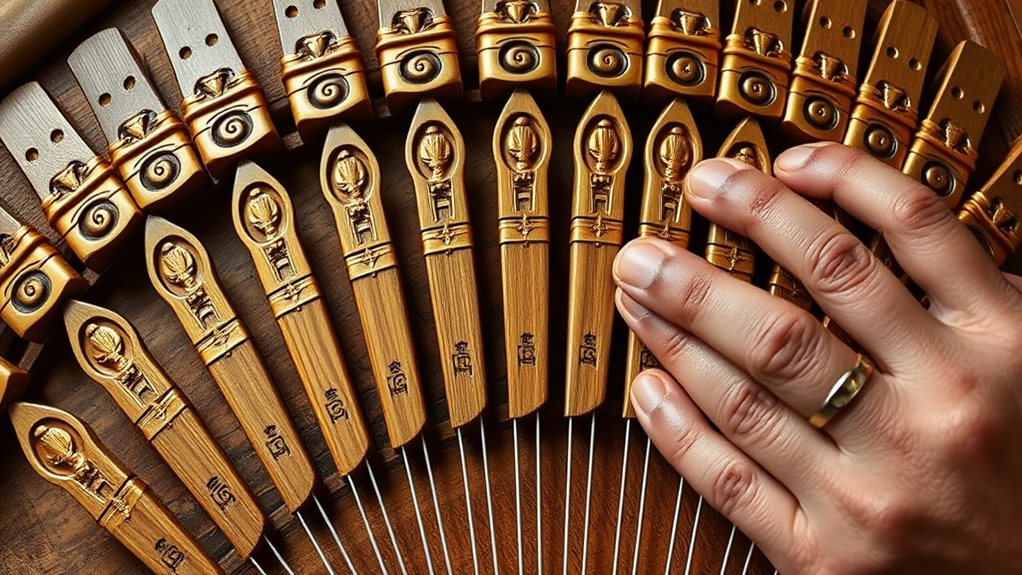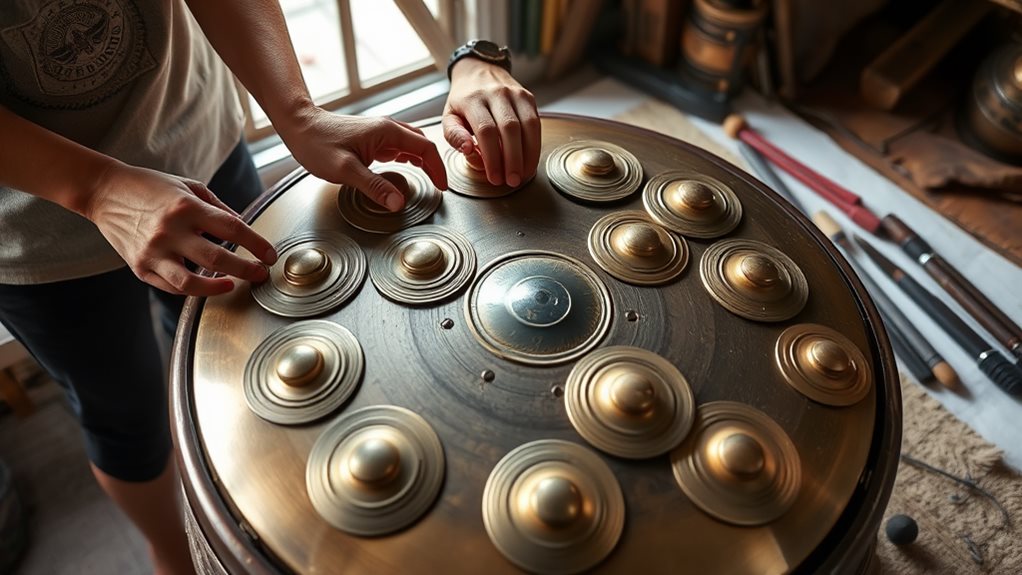You begin the intricate process of kulintang tuning by adjusting the size and thickness of gongs to achieve a specific pentatonic scale, enhancing melodic interplay unique to this gong-chime instrument from the Philippines. Musicians use ear training and traditional methods, sometimes heating gongs over a flame to expand metal. Each kulintang ensemble consists of eight gongs made from bronze or brass, each with a distinct pitch. Tuning practices vary among regions, reflecting diverse cultural influences and preferences. Regular maintenance, including checking gongs and cleaning beaters, ensures the quality of sound and longevity of the instrument. Exploring further, you'll uncover how these practices serve cultural significance and identity among indigenous communities.
Historical Context

Kulintang, a gong-chime musical instrument, originated in the Philippines, deeply rooted in the gong culture of Southeast Asia, reflecting significant historical ties to indigenous musical practices.
You'll find it classified as an idiophone percussion type, featuring small gongs struck with wooden beaters. Played for centuries across the Philippines, Indonesia, Malaysia, Brunei, and East Timor, the kulintang holds a crucial place in cultural ceremonies and social gatherings.
Historical documentation emphasizes its role in expressing Filipino identity and heritage. This instrument's evolution mirrors the diverse cultural influences and musical traditions of the regions it spans, preserving the rich heritage of the communities that practice it.
Performances of kulintang music have historically been linked to communal bonding, storytelling, and the transmission of cultural narratives across generations, highlighting its importance in the cultural fabric of Mindanao.
Through these oral traditions and cultural practices, the kulintang continues to serve as a powerful symbol of cultural identity among indigenous communities.
Tuning Techniques
Originating in the heart of Southeast Asia, the instrument has evolved beyond its historical context to be a central element in various cultural expressions.
Tuning kulintang gongs involves adjusting their size and thickness, ensuring that a pentatonic scale is achieved. This scale facilitates melodic interplay among the gongs, contributing to the cultural richness of indigenous music.
Musicians rely on a combination of ear training and traditional methods to tune the gongs accurately, often using striking techniques to compare pitches. Heating the gongs over a flame to expand the metal and adjusting them before cooling is a refined practice.
Each ensemble may have its unique tuning system, reflecting regional practices and preferences, thus adding to the diversity of kulintang music across different communities.
Instrument Components

A typical kulintang ensemble includes eight graduated gongs laid out horizontally, each designed to produce a distinct pitch and form a core part of its melodic structure.
These gongs, made from bronze or brass, vary in size and thickness to influence their tonal quality and resonance. Each gong acts as a tuned gong, adding its unique sound to the ensemble's overall musical tapestry.
To play the kulintang, you use two wooden mallets, enabling you to create a range of dynamic expressions and intricate rhythms.
Besides the kulintang, a rhythmic ensemble often includes the agung, the largest gong, and the gandingan, a set of hanging gongs, each contributing to the ensemble's rich sound.
This ensemble, grounded in a pentatonic scale, allows for diverse melodic possibilities, enhancing the cultural expressiveness of your performances.
Cultural Importance
Understanding the profound role of kulintang music becomes crucial when recognizing how it serves as a vital expression of your identity, particularly among Muslim communities in Mindanao, reflecting cultural heritage and social status.
Kulintang music is an integral part of various celebrations and rituals, such as weddings and harvests, strengthening bonds within social gatherings. Storytelling and dance often accompany these performances, preserving oral traditions like Danongan Kalanduyan across generations.
The unique tuning and arrangement of gongs create distinct melodic and rhythmic patterns that are emblematic of traditional Filipino music.
As a symbol of resistance against colonial influences, kulintang embodies the historical narrative of the Moro people's struggle for cultural preservation and identity.
Maintenance Practices

Checking and adjusting the Kulintang's gongs regularly ensures they maintain their intended pitch and resonance. This practice, part of essential maintenance practices for traditional musical instruments made of metal, is crucial for preserving sound quality.
Start by cleaning the gongs with a soft, dry cloth to remove dust and moisture that can dampen sound and cause corrosion. Store the kulintang in a cool, dry place away from direct sunlight to prevent warping and damage to its metal and wooden components.
Keep an eye on the wooden beaters for wear and tear, replacing them as needed to maintain optimal striking efficiency and protect the gongs from further damage. Finally, periodically consult with experienced kulintang players or artisans for professional advice, which helps preserve the instrument's quality and longevity.
Questions and Answers
What Is the Tuning System of Kulintang?
You learn kulintang tuning through techniques that create a pentatonic scale, influencing melodic structure with regional differences, scale variations, and cultural significance impacting performance practice and historical context.
Is Kulintang Islamic?
Kulintang history intertwines Islamic elements, yet its cultural significance transcends religion. As part of musical traditions, it varies regionally, engages communities, presents spiritual connections, and faces tuning challenges distinctly.
What Is the Difference Between Kulintang and Gamelan?
Kulintang history ties to Moro communities; instruments are 8 tuned gongs; techniques emphasize rhythmic patterns; performances feature traditional dances; culturally significant, with regional variations; music theory based on pentatonic scale; composers create unique pieces; celebrated in festivals.
What Does Kulintang Symbolize?
Kulintang symbolizes cultural significance and musical heritage, expressing community identity through traditional practices and spiritual connections at social gatherings as an artistic expression featuring regional variations and historical roots.